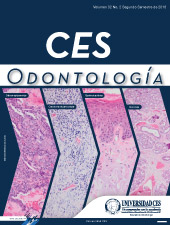Use of absolute isolation with rubber dam in restorative treatments by oral rehabilitators in the department of Antioquia
DOI:
https://doi.org/10.21615/cesodon.31.2.3Keywords:
Isolation, Rubber dam, Survey, Oral rehabilitationAbstract
Introduction and Objective: The absolute isolation of the operative field with rubberdam (DG), is essential for the successful outcome of the endodontic and restorativetreatment. To date, there is no scientific evidence to support its use among oral rehabilitators.The purposes of this study were: to determine the frequency of the use of DG as a method of absolute isolation, to identify which socio-demographic variablesinfluenced its use, and to know the main reasons for its use or not by oral rehabilitatorsof the department of Antioquia during the restorative procedures. Materials andmethods: A self-diligent survey with 17 questions was done to 77 oral rehabilitators.A descriptive uni-variate and bivariate statistical analysis using Pearson’s chi-squaretest was used to determine the association between demographic factors and theuse or not of the DG (P <0.05). Results: In general, the prevalence of the use of theDG was 89.6% confidence interval, 95% (82.8% - 96.4%), being higher in the posteriorsector 61.1%, followed by 55.9% in the previous sector, 19.5% post cementationand 14, 3% in the development of posts. Meanwhile, the lack of time with 44.2% andnot seeing the need 28.6%, were the most prevalent reasons for omitting the use ofthe DG; the humidity control with 81.8% and improve the adhesion 71.4%, justifiedits use. Clinical experience was the only variable that influenced the use of DG (P =0.03). Conclusion: The use of DG was more frequent for the posterior sector than theprevious one, and frequently omitted for the elaboration and cementation of posts.Downloads
References
European Society of Endodontology. Quality guidelines for endodontic treatment: consensus report of the European Society of Endodontology. Int Endod J. 2006;39(12):921-930.
Ammann P, Kolb A, Lussi A, Seemann R. Influence of rubber dam on objective and subjective parameters of stress during dental treatment of children and adolescents - a randomized controlled clinical pilot study. Int J Paediatr Dent. 2013;23(2):110-115.
Cochran MA, Miller CH, Sheldrake MA. The efficacy of the rubber dam as a barrier to the spread of microorganisms during dental treatment. J Am Dent Assoc. 1989;119(1):141-144.
Samaranayake LP, Reid J, Evans D. The efficacy of rubber dam isolation in reducing atmospheric bacterial contamination. ASDC J Dent Child. 1989;56(6):442-444.
Liebenberg WH. Extending the use of rubber dam isolation: alternative procedures. Part I. Quintessence International. 1992;23(10):657-657-665.
Thorpe BL. History of Dental Surgery. Biographies of Pioneer American Dentists and Their Successors. Koch C, editor. Vol. 3. National Art Publishing Co.; 1910. 417 p.
Hitmi L, Attal JP, Degrange M. Influence of the time-point of salivary contamination on dentin shear bond strength of 3 dentin adhesive systems. J Adhes Dent. 1999;1(3):219-232.
Knight GT, Barghi N, Berry TG. Comparing two methods of moisture control in bonding to enamel: a clinical study. Oper Dent. 1991;16(4):130-135.
Stape THS, Tjäderhane L, Abuna G, Sinhoreti MAC, Martins LRM, Tezvergil-Mutluay A. Optimization of the etch-and-rinse technique: New perspectives to improve resin–dentin bonding and hybrid layer integrity by reducing residual water using dimethyl sulfoxide pretreatments. Dental Materials. 2018;34(7):967-977.
Choi A-N, Lee J-H, Son S-A, Jung K-H, Kwon YH, Park J-K. Effect of Dentin Wetness on the Bond Strength of Universal Adhesives. Materials (Basel). 2017;10(11).
Kapitán M, Sustova Z, Ivancakova R, Suchanek J. A comparison of different rubber dam systems on a dental simulator. Acta Medica (Hradec Kralove). 2014;57(1):15-20.
Lawson NC, Gilbert GH, Funkhouser E, Eleazer PD, Benjamin PL, Worley DC. General Dentists’ Use of Isolation Techniques during Root Canal Treatment: From the National Dental Practice-based Research Network. J Endod. 2015;41(8):1219-1225.
Tanalp J, Kayataş M, Can EDB, Kayahan MB, Timur T. Evaluation of senior dental students’ general attitude towards the use of rubber dam: a survey among two dental schools. ScientificWorldJournal. 2014;2014:290101.
Kapitán M, Sustová Z. The use of rubber dam among Czech dental practitioners. Acta Medica (Hradec Kralove). 2011;54(4):144-148.
Unal GC, Kaya BU, Tac AG, Kececi AD. Survey of attitudes, materials and methods preferred in root canal therapy by general dental practice in Turkey: Part 1. Eur J Dent. 2012;6(4):376-384.
Raoof M, Zeini N, Haghani J, Sadr S, Mohammadalizadeh S. Preferred materials and methods employed for endodontic treatment by Iranian general practitioners. Iran Endod J. 2015;10(2):112-116.
Soldani F, Foley J. An assessment of rubber dam usage amongst specialists in paediatric dentistry practising within the UK. Int J Paediatr Dent. 2007;17(1):50-56.
Savani GM, Sabbah W, Sedgley CM, Whitten B. Current Trends in Endodontic Treatment by General Dental Practitioners: Report of a United States National Survey. J Endod. 2014;40(5):618-624.
Fernández R, Monsalve S, Vásquez J, Robayo J, Lacouture O, Álvarez G. Rubber dam use in endodontic treatment and restorative dentistry by general dentists in a South American Sub-population. Int J Endod Rehab. 2016;2(1):29-38.
Al-Omari WM. Survey of attitudes, materials and methods employed in endodontic treatment by general dental practitioners in North Jordan. BMC Oral Health [Internet]. 2004 [citado 28 de julio de 2016];4(1). Disponible en: http://bmcoralhealth.biomedcentral.com/articles/10.1186/1472-6831-4-1
Mathias P, Rocha V, Saraiva L, Cavalcanti AN, Azevedo JF, Paulillo LAMS. Intraoral environment conditions and their influence on marginal leakage in composite resin restorations. Acta Odontol Latinoam. 2010;23(2):105-110.
Jacquot B, Durand J-C, Farge P, Valcarcel J, Deville de Périère D, Cuisinier F. Influence of temperature and relative humidity on dentin and enamel bonding: a critical review of the literature. Part 1. Laboratory studies. J Adhes Dent. 2012;14(5):433-446.
Lynch CD, McConnell RJ. Attitudes and use of rubber dam by Irish general dental practitioners. Int Endod J. 2007;40(6):427-432.
Feizbakhsh M, Aslani F, Gharizadeh N, Heidarizadeh M. Comparison of bracket bond strength to etched and unetched enamel under dry and wet conditions using Fuji Ortho LC glass-ionomer. J Dent Res Dent Clin Dent Prospects. 2017;11(1):30-35.
Whitworth JM, Seccombe GV, Shoker K, Steele JG. Use of rubber dam and irrigant selection in UK general dental practice: UK endodontic practice. Int Endod J. 2000;33(5):435-441.
Mala S, Lynch CD, Burke FM, Dummer PMH. Attitudes of final year dental students to the use of rubber dam. Int Endod J. 2009;42(7):632-638.
Zou H, Li Y, Lian X, Yan Y, Dai X, Wang G. Frequency and Influencing Factors of Rubber Dam Usage in Tianjin: A Questionnaire Survey. Int J Dent. 2016;2016:7383212.
Demarco FF, Baldissera RA, Madruga FC, Simões RC, Lund RG, Correa MB, et al. Anterior composite restorations in clinical practice: findings from a survey with general dental practitioners. J Appl Oral Sci. 2013;21(6):497-504.
Joynt RB, Davis EL, Schreier PH. Rubber dam usage among practicing dentists. Oper Dent. 1989;14(4):176-181.
Van Meerbeek B, De Munck J, Yoshida Y, Inoue S, Vargas M, Vijay P, et al. Buonocore memorial lecture. Adhesion to enamel and dentin: current status and future challenges. Oper Dent. 2003;28(3):215-235.
Barros de Campos PR, Maia RR, Rodrigues de Menezes L, Barbosa IF, Carneiro da Cunha A, da Silveira Pereira GD. Rubber dam isolation--key to success in diastema closure technique with direct composite resin. Int J Esthet Dent. 2015;10(4):564-574.
Feierabend SA, Matt J, Klaiber B. A comparison of conventional and new rubber dam systems in dental practice. Oper Dent. 2011;36(3):243-250.
Knight GT, Berry TG, Barghi N, Burns TR. Effects of two methods of moisture control on marginal microleakage between resin composite and etched enamel: a clinical study. Oper Dent. 1993;6(5):475-479.
Daudt E, Lopes G, Vieira L. Does Operatory Field Isolation Influence the Performance of Direct Adhesive Restorations? J Adhes Dent. 2013;(1):27–32.
Madison S, Wilcox LR. An evaluation of coronal microleakage in endodontically treated teeth. Part III. In vivo study. J Endod. 1988;14(9):455-458.
Gillen BM, Looney SW, Gu L-S, Loushine BA, Weller RN, Loushine RJ, et al. Impact of the quality of coronal restoration versus the quality of root canal fillings on success of root canal treatment: a systematic review and meta-analysis. J Endod. 2011;37(7):895-902.
Goldfein J, Speirs C, Finkelman M, Amato R. Rubber dam use during post placement influences the success of root canal-treated teeth. J Endod. 2013;39(12):1481-1484.
Smales RJ. Rubber dam usage related to restoration quality and survival. Br Dent J. 1993;174(9):330-333.
Van Dijken JW, Hörstedt P. Effect of the use of rubber dam versus cotton rolls on marginal adaptation of composite resin fillings to acid-etched enamel. Acta Odontol Scand. 1987;45(5):303-308.
Deprá MB, de Almeida JX, da Cunha T de MA, Lon LFS, Retamoso LB, Tanaka OM. Effect of saliva contamination on bond strength with a hydrophilic composite resin. Dental Press J Orthod. 2013;18(1):63-68.
Cunha T de MA da, Behrens BA, Nascimento D, Retamoso LB, Lon LFS, Tanaka O, et al. Blood contamination effect on shear bond strength of an orthodontic hydrophilic resin. J Appl Oral Sci. 2012;20(1):89-93.
Bassir L, Khanehmasjedi M, Nasr E, Kaviani A. An in vitro comparison of microleakage of two self-etched adhesive and the one-bottle adhesive used in pit and fissure sealant with or without saliva contamination. Indian J Dent Res. 2012;23(6):806.
Farmer SN, Ludlow SW, Donaldson ME, Tantbirojn D, Versluis A. Microleakage of composite and two types of glass ionomer restorations with saliva contamination at different steps. Pediatr Dent. 2014;36(1):14-17.
Downloads
Published
How to Cite
Issue
Section
License
Copyright (c) 2021 CES Odontología

This work is licensed under a Creative Commons Attribution-NonCommercial-ShareAlike 4.0 International License.
| Article metrics | |
|---|---|
| Abstract views | |
| Galley vies | |
| PDF Views | |
| HTML views | |
| Other views | |



